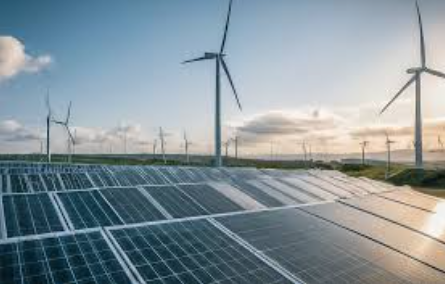Unlocking the Potential of Renewable Energy in India: A Strategic Approach (GS Paper 3, Renewable Energy)

Introduction
- The Ministry of New and Renewable Energy (MNRE) has recently urged states to facilitate land accessibility for renewable energy ventures, specifically wind power.
- With India’s current wind power capacity standing at 47.95 GW, the objective is to escalate this figure to 100 GW and enhance land utilization to achieve the ambitious 500-GW non-fossil fuel target by 2030.
What Constitutes Renewable Energy?
- Renewable energy refers to energy harnessed from inexhaustible, environmentally benign natural resources, including solar, wind, hydro, biomass, geothermal, and tidal.
- These energy sources, in contrast to fossil fuels, are sustainable and contribute significantly to the reduction of carbon emissions.
Key Types of Renewable Energy:
- Solar Energy: Captured from the sun’s radiation using photovoltaic panels or solar thermal systems.
- Wind Energy: Harnessed by converting wind’s kinetic energy into electricity using wind turbines.
- Hydropower: Generated by exploiting the kinetic energy of flowing water, whether through dams or river systems.
- Biomass Energy: Derived from organic matter (e.g., plant waste, animal residues) for the generation of heat, power, or biofuels.
- Geothermal Energy: Exploits the earth’s internal heat sources (e.g., hot springs, steam) for power generation and direct heating.
- Tidal & Wave Energy: Taps into oceanic movement (tides and waves) to generate electricity.
Renewable Energy Status in India
As of November 2024, India boasts a total renewable energy capacity of 158.55 GW, reflecting significant progress toward a green energy transition.
- Wind Power: India has reached 47.96 GW in wind power capacity, with an addition of 2.07 GW in FY 2024-25.
- Solar Power: Leading with 94.17 GW in solar capacity, including 15.16 GW from grid-connected rooftop systems and 4.10 GW from off-grid solar applications.
- Hydropower: Small Hydro Power contributes 5.08 GW, focused on tapping into river currents for sustainable energy.
- Biomass Energy: Contributes 10.72 GW, with a significant portion coming from bagasse-based cogeneration (9.80 GW).
- Waste-to-Energy: Provides 0.61 GW, demonstrating innovation in waste management and clean energy production.
India’s Renewable Energy Potential
India holds substantial untapped potential in various renewable energy sectors:
- Solar Energy: With an average of 300 sunny days annually, the potential for solar power is estimated at 748 GW, assuming 3% of wasteland is utilized for solar installations. States like Rajasthan, Gujarat, and Tamil Nadu are leading the charge with large solar parks.
- Wind Energy: The nation’s wind energy potential exceeds 300 GW, primarily concentrated in Tamil Nadu, Gujarat, Maharashtra, Andhra Pradesh, and Karnataka. Emerging offshore wind projects off the coasts of Gujarat and Tamil Nadu could further enhance capacity.
- Hydropower: India has 148 GW of estimated hydroelectric potential, with over 46 GW yet to be developed. Small hydropower projects (<25 MW) offer a significant growth area, particularly in the Himalayan and northeastern regions.
- Geothermal Energy: Promising geothermal resources exist in states like Ladakh, Himachal Pradesh, and Jharkhand, potentially yielding 10 GW of capacity.
- Ocean Energy: Coastal regions, including the Gulf of Kutch and the Sundarbans, harbor the potential for 40 GW of tidal and wave energy.
Key Challenges to Renewable Energy Expansion in India
Several obstacles impede the rapid scaling of renewable energy, especially wind power:
- Land Availability and Usage Conflicts: In densely populated or ecologically sensitive regions, securing land for renewable energy projects, particularly wind farms, presents significant hurdles. Fragmented land ownership complicates the acquisition of contiguous land, especially in states like Gujarat, Maharashtra, and Tamil Nadu.
- Financing and Investment Barriers: Wind energy projects require substantial capital investments. The uncertainty regarding long-term returns and the prolonged payback periods deter private sector participation.
- Grid Integration Challenges: Due to the intermittent nature of wind energy and the seasonal variability of wind patterns, grid curtailment during peak generation periods reduces profitability and disrupts grid stability.
- Exhaustion of Prime Wind Sites: Optimal wind locations have largely been occupied, forcing new wind farms to be established in suboptimal areas.
- Approval and Policy Delays: Wind projects face significant delays in receiving clearances, particularly in relation to environmental, wildlife, and forest approvals. Additionally, the lack of stable policies and financial incentives undermines investor confidence.
- Offshore Wind Challenges: Offshore wind potential remains underdeveloped due to high installation costs, technological complexity, and insufficient government support.
India’s Strategic Initiatives to Promote Renewable Energy
Several initiatives have been launched to address the challenges and foster the growth of renewable energy:
- PM-KUSUM: Pradhan Mantri Kisan Urja Suraksha Evam Utthaan Mahabhiyan promotes solar power generation among farmers.
- PLI Scheme: The Production Linked Incentive (PLI) Scheme aims to incentivize the production of solar photovoltaic (PV) modules in India.
- National Green Hydrogen Mission: Aimed at developing green hydrogen as an alternative energy source.
- National Bioenergy Programme: Supports the development of bioenergy from agricultural and waste residues.
Strategic Way Forward
- Enhancing Land Access: Clear and transparent policies should be developed for the acquisition of government land and streamlined procedures via digitized land records and the creation of designated renewable energy zones.
- Strengthening Grid Infrastructure: Expedited development of green energy corridors is critical to linking renewable energy projects with urban demand centers. Investments in hybrid systems that integrate solar, wind, and storage are essential for stabilizing power output.
- Harmonizing National Policies: A unified national renewable energy policy should address disparities in state-level regulations. Long-term incentives, such as tax exemptions and performance-based rewards, can attract investors.
- Promotion of Offshore Wind: Pilot projects in offshore wind should be supported with financial incentives, reduced import duties on specialized equipment, and enhanced government collaboration.
- Financing and Research: Establishment of green banks to provide affordable financing, alongside significant investments in research and development (R&D), will foster technological advancements and reduce costs.
- Environmental Sustainability: Rigorous environmental assessments must be conducted, alongside promoting the recycling of energy components and ensuring community engagement to balance development with ecological sustainability.
Conclusion
- India’s renewable energy journey is crucial not only for achieving climate goals but also for enhancing energy security and creating economic opportunities.
- By overcoming land access barriers, improving grid infrastructure, and streamlining policies, India can unlock its vast potential, ensuring a robust, green energy future.


